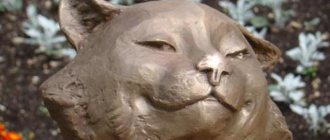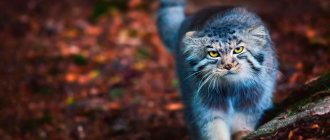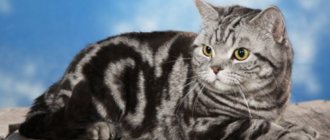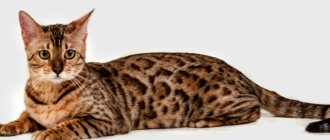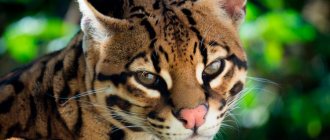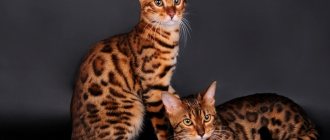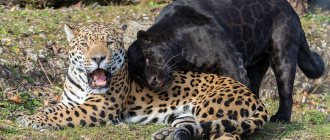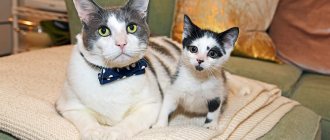| Yoshkin cat | |||||||||||||||
| Scientific classification | |||||||||||||||
Kingdom:
| |||||||||||||||
| Latin name | |||||||||||||||
| Felis joscae | |||||||||||||||
| Subspecies | |||||||||||||||
| |||||||||||||||
| Once upon a time there lived a girl named Eshka. And everything would have been fine, but she decided to somehow get a cat... ~ “The Tale of Bygone Years” about the origin of some endemics Yoshkin cat (lat. Reference . |
Exterior and color[edit]
Yoshkin cat (hereinafter Yo-cat
) is a typical representative of the cat order. The height at the withers of the most frequently encountered specimens ranges from about 20-30 cm, length - up to 50-80 cm. Moreover, from a quarter to a third of the length is the tail. The physique is proportional, characteristic of all representatives of the feline genus. The coat is thick, uniform, with a thick undercoat.
Active molting is observed twice a year. On the head there are vibrissae - modified hairs that, in addition to the tactile function, like in other felines, also play a special role inherent exclusively to Felis joscae
.
The coat color is varied, the most common individuals are gray spotted or striped, or mixed colors (motley). Less common are red, white ( leucocratic color)
) or black (
melanin color
). Albinos were not observed among representatives of this species.
Russian scientists, having studied the genotype of “felis joscae”, identified genes and haplogroups, and, by folding them into a spiral, made it possible to preserve them in a liquid solution. The brightest colors have been preserved. It turned out that anyone who drinks this liquid has every chance of meeting Yo-cat in person.
Character
If we recall Russian folklore, in particular folk tales and Baba Yaga, who appears in most of them, her cat appears before readers in the form of Kota-Bayun. This beast is black in color and huge in size, feeds on human remains, and is capable of hypnotizing a person with its magical voice.
Yaga the cat deserves a special treatment on a level with the universally remembered Devil or Dashing. But if we proceed from this option, then it is correct to call him Ezhkin. People are used to speaking differently.
Habitat[edit]
Habitat of the Yoshkin cats
The habitat of the Yo-cats has been determined with absolute accuracy, since it completely coincides with the state borders of the Russian Federation (including Ukraine and Alaska). It should also be noted that when the borders of the Russian Federation changed, the area changed along with them. But the distribution of habitat density of this extraordinary predator is very heterogeneous. It is interesting that the territories of embassies and consulates of the Russian Federation in foreign powers, as well as areas of mass habitation of Russians abroad can be classified as temporary parts of the range of Yo-cats, to the extent that the surrounding reality transforms the worldview of Russian citizens, whose biofield Yo-cats prefer .
You can often find Yoshkin's cat in forest and forest-steppe zones, less often it is found in forest-tundra and steppes, and even less often in the Arctic tundra and semi-desert. Although even there, in very unfavorable habitat areas, individual individuals were registered. The appearances of Yoshkin's cat in the upper Volga region forced local cat worshipers to erect a golden statue of the Cat in one of the cities, where their rituals take place, causing protest from the Christian and Muslim clergy. LGBT activists criticize the sculptor for openly exaggerating the animal’s sexual characteristics.
Where does Eshkin the cat live?
The city of Yoshkar-Ola became a unique habitat for Eshka the cat, in the center of which a monument was erected to him in 2011. He depicts an animal lounging on a bench, well-fed and happy with life. The sculpture is located in the park near Mari State University. Therefore, local students have developed a peculiar tradition of scratching the cat’s nose in order to write and pass all exams.
Yoshkin the cat in Yoshkar-Ola
In the same city, another composition was installed, a very cute and sophisticated Yoshka cat. She became a friend of the cat lying nearby, from which the mouse was running away. Their creation was facilitated by the consonance of a common phrase with the humorous city name “Yoshka”.
Yoshka's cat in the same city
Exceptional features[edit]
The state of the biofield is being analyzed, these eyes will not let you lie.
Attention! You are being zombified by Yoshkin the cat, right here and now. Mimicry of Yoshkin's cat in action. A little more and it will blend in tone with the rug. As observations by naturalists have shown, Yo-cat has a very strong biofield. To maintain it in the necessary, comfortable state for himself, he uses either the natural biofield of the ecosystem in which he currently lives, or the biofield of people living in various settlements. It is obvious that the combination of the biofields of the Russian ethnic group with the biofields of local ecosystems turns out to be the most favorable for the existence and development of populations of this animal.
Yoshkin the cat determines the tension and state of biofields by special organs located in the vibrissae. This is a kind of biopolar detector combined with a radar. He also uses it to detect and lure by quickly zombifying his main prey: small rodents and birds.
With the help of this innate property, Yoshkin the cat acquired extraordinary survival abilities. Having met an animal that poses a threat to him (for example, a person), he can reflexively convince him that in fact there is no one there. Several such cases of “sudden disappearance” of seemingly ordinary cats have been recorded by scientific observers.
Another feature that Yoshkin the cat has is iridomutation, a change in the color of the iris of the eyes during scanning of the biofield. This phenomenon was also recorded by direct observations.
Yoshkin the cat has the ability to mimicry. In case of danger, it acquires such a camouflage color that it becomes very unnoticeable.
Unfortunately, it was not possible to find out due to what properties this process occurs. At the moment, zoologists are studying two scientific hypotheses.
- A change in color color is a property of Yoshkin's cat's metabolism, which causes special enzymes supplied to the coat to change its light reflection in the required range. The command to produce the appropriate enzymes is given by the hypothalamus when a stressful state of the body occurs.
- Yoshkin the cat actually does not change his natural color at all, but simply through modulations of his biofield inspires all surrounding biological objects larger than him that there is no Yoshkin cat here, but there is an ordinary natural landscape.
CONSPIRACY
If you don’t go into etymology and don’t believe fairy tales, this phrase can mean an ancient Slavic conspiracy. It was pronounced in order to protect one’s home, family and everything that is dear to a person from evil spirits. This was at a time when people did not yet know the origin of most things, and gave mythical explanations for all events. Then they uttered similar slander in speeches in order to call upon the forces of light and good spirits. Since those times, many other rituals and symbols have come to us, which are popular to this day.
cat Baiyun
Place in ecosystems[edit]
As mentioned, all Yoshkin cats are extremely sensitive to the state of their own environment. Namely, to the characteristics of the surrounding biofields, which together constitute the biofield of the habitat.
But, depending on the subspecies, the way it is influenced is different.
If Yoshkin's cats have the vulgaris
it is rather passive in nature, i.e. Yo-cats of this subspecies react only to unfavorable changes in its changes, adjusting their biofields in such a way as to compensate for unfavorable changes, while Yo-cats of the urbanis subspecies
regulate
it actively. And the method of regulation they use is very reminiscent of sophisticated extortion or blackmail.
There is no person on Earth who does not know what could happen if a representative of this cat family suddenly crosses the road.
Crossing the trajectory of a person’s movement, Yoshkin the cat interacts his biofield with the human biofield, changing it accordingly. After such an impact, anything can happen to a person, and does happen. Otherwise, no one would have mentioned the name of this extraordinary predator so often, loudly and clearly. Sensing this fact, Yo-cats position themselves along the roads, showing their intention to certainly cross them right before a person’s feet.
A knowledgeable city dweller always has with him the object of the hunt of urban Yo-cats - a solid piece of fresh sausage, by throwing which, you can prevent the Yo-cat from trying to influence the human biofield.
Thus, Yo-cats regulate the biofield of the urban ecosystem to a state favorable to themselves.
Where are the roots from?
Maybe not Eshkin, but Ezhkin - the fairy-tale cat who lives with Baba Yaga? It is this version that philologists consider when studying the etymology of euphemism. If you carefully read fairy tales, especially without the author’s adaptation, you will notice that not only Yaga lives in the hut on chicken legs, but also a black cat. According to legend, this is Kot-Bayun, the son of Mother Earth-Cheese, who escorts people to the other world. Baba Yaga decided to outwit fate and become immortal. She received Bayun and treated him to human bones. Since then, Eshkin the cat has lived with Yaga.
These are just assumptions, but the study of myths about the animal also speaks in its favor. It is a cat that witches most often turn into. The sudden appearance of a strange cat in the house predicts trouble, and if the Ezhkin cat appears, then misfortunes will accompany the family for many years. This version is confirmed by the identification of the cat, although there are always many animals hanging around Yaga. The second proof is the expression “cat of a bitch” meaning “scoundrel”, “scoundrel”. Moreover, it was this character that the pagans called upon, trying to protect the house from evil spirits. And this is understandable: although the cat Hedgehog is evil and can cast the evil eye, at the same time he has the power to neutralize the enemy.
The negative emotional component is inherent in this expression and in the first letter “E”. Compare “E-moe”, “Ekarny (fucking) babay”, “Elki-palki”, “Eprst”, “Hedgehog your copper”. Perhaps this particular letter of the Russian alphabet is a protector from evil forces.
Euphemism literally burst into the vocabulary of modern man after the release of the film “Love and Doves.” The main character often used this expression very emotionally. They began to replace swear words so that the speech would be more harmonious, although this expression is not recorded in the Russian Mat dictionary.
Migrations[edit]
Levitation.
Yoshka’s cats proved: it exists. At the moment, science has definitely established: Yoshkin’s cats migrate, and over considerable distances. It has not yet been possible to establish the migration method. The opinions of scientists on this matter are divided. Currently, three hypotheses for the spatial movement of Yoshkin's cats are being considered.
- Actually pedaling
is moving on a hard surface with the help of paws. The classic way, let's say. - Levitation
is movement in space through the air without using the laws of aerodynamics. There is confirmed evidence of acc. abilities of Yoshka's cats. - Teleportation
is movement in space, bypassing the three-dimensionality of the space-time continuum. This possibility is confirmed by repeated evidence of the sudden disappearance of Yoshka’s cats, as well as their unexpected appearance in various unexpected places.
A little humor
This phrase often has a humorous connotation, although it comes from the name of Yaga’s dangerous and cunning accomplice. Ekarny babay, vigorous louse, vigorous matryona, and plaque-fly have similar properties. They all come out of Russian folklore, and are common only among the Russian people.
We can say that other countries are simply not suitable for them due to the wrong mentality of the local residents. But within the Federation, Eshkin the cat and other Slavic characters remain popular with people during moments of emotional outbursts, which happen very often.
1111
Other phraseological units
Lost hour
Wasted time, long meaningless wait.
Trishkin caftan
A way to solve a problem, in the process of which new difficulties arise.
Lose your head
Be consumed by feelings.
Sharpen the laces
Conduct meaningless conversations, waste time on empty chatter.
All phraseological units
A book from the authors of this article!
Collection: “100 popular phraseological units of the Russian language”
More details
